Human Development Across the Lifespan
VerifiedAdded on 2023/06/10
|7
|1625
|393
AI Summary
This report discusses the physical and behavioral changes that occur during adolescence, with a focus on the impact of puberty on physical growth and maturity. It also explores the development of brain structure and its role in risk-taking behavior, as well as the importance of parental guidance and monitoring.
Contribute Materials
Your contribution can guide someone’s learning journey. Share your
documents today.
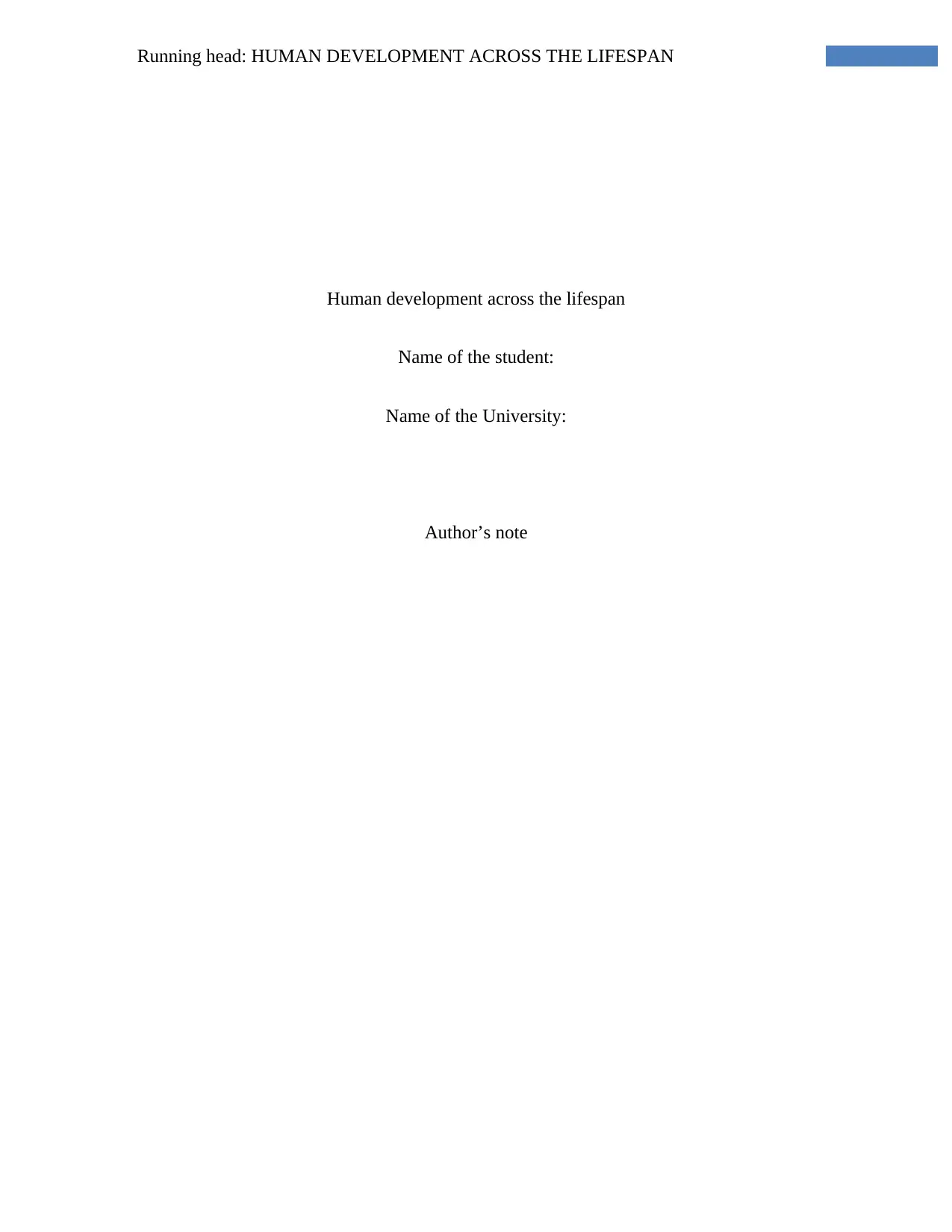
Running head: HUMAN DEVELOPMENT ACROSS THE LIFESPAN
Human development across the lifespan
Name of the student:
Name of the University:
Author’s note
Human development across the lifespan
Name of the student:
Name of the University:
Author’s note
Secure Best Marks with AI Grader
Need help grading? Try our AI Grader for instant feedback on your assignments.
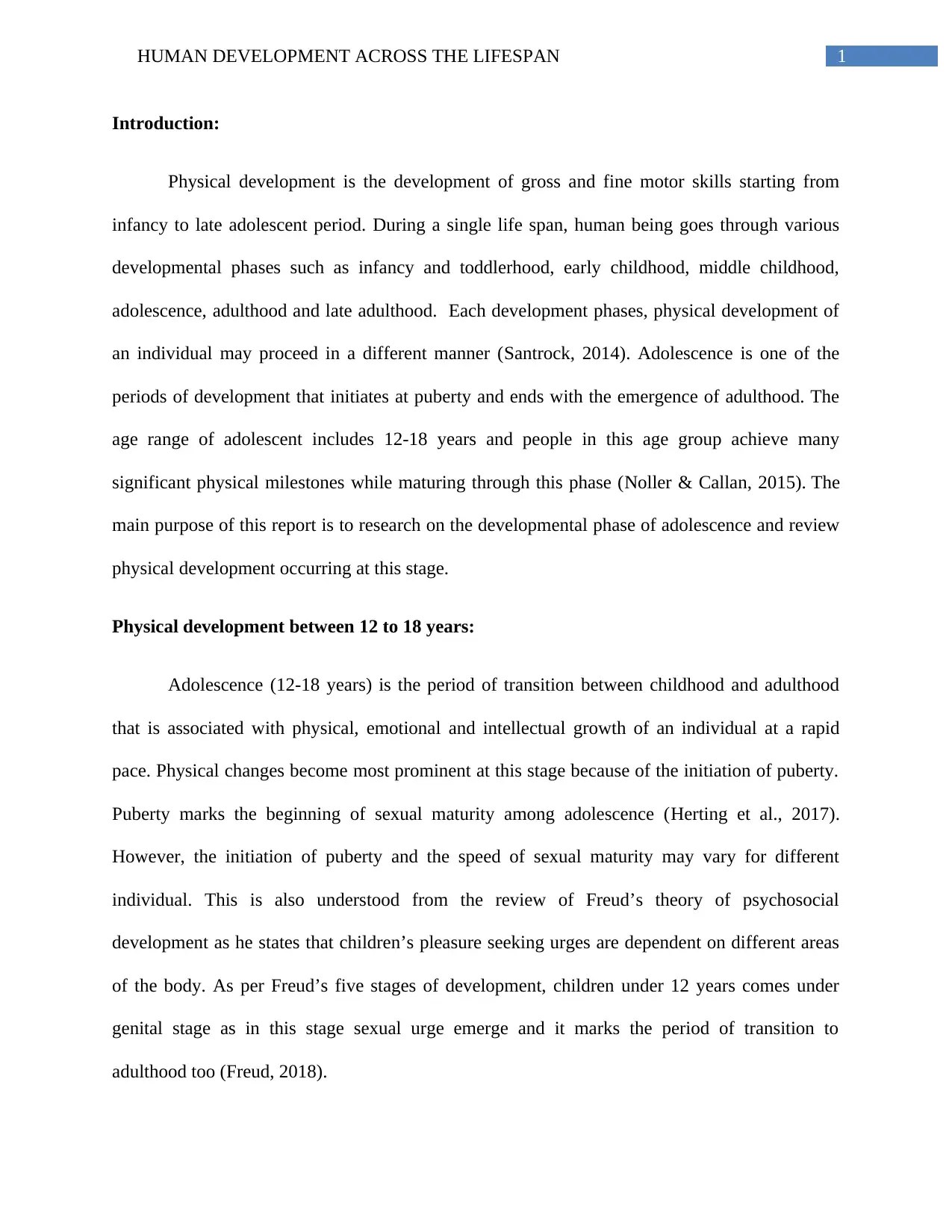
1HUMAN DEVELOPMENT ACROSS THE LIFESPAN
Introduction:
Physical development is the development of gross and fine motor skills starting from
infancy to late adolescent period. During a single life span, human being goes through various
developmental phases such as infancy and toddlerhood, early childhood, middle childhood,
adolescence, adulthood and late adulthood. Each development phases, physical development of
an individual may proceed in a different manner (Santrock, 2014). Adolescence is one of the
periods of development that initiates at puberty and ends with the emergence of adulthood. The
age range of adolescent includes 12-18 years and people in this age group achieve many
significant physical milestones while maturing through this phase (Noller & Callan, 2015). The
main purpose of this report is to research on the developmental phase of adolescence and review
physical development occurring at this stage.
Physical development between 12 to 18 years:
Adolescence (12-18 years) is the period of transition between childhood and adulthood
that is associated with physical, emotional and intellectual growth of an individual at a rapid
pace. Physical changes become most prominent at this stage because of the initiation of puberty.
Puberty marks the beginning of sexual maturity among adolescence (Herting et al., 2017).
However, the initiation of puberty and the speed of sexual maturity may vary for different
individual. This is also understood from the review of Freud’s theory of psychosocial
development as he states that children’s pleasure seeking urges are dependent on different areas
of the body. As per Freud’s five stages of development, children under 12 years comes under
genital stage as in this stage sexual urge emerge and it marks the period of transition to
adulthood too (Freud, 2018).
Introduction:
Physical development is the development of gross and fine motor skills starting from
infancy to late adolescent period. During a single life span, human being goes through various
developmental phases such as infancy and toddlerhood, early childhood, middle childhood,
adolescence, adulthood and late adulthood. Each development phases, physical development of
an individual may proceed in a different manner (Santrock, 2014). Adolescence is one of the
periods of development that initiates at puberty and ends with the emergence of adulthood. The
age range of adolescent includes 12-18 years and people in this age group achieve many
significant physical milestones while maturing through this phase (Noller & Callan, 2015). The
main purpose of this report is to research on the developmental phase of adolescence and review
physical development occurring at this stage.
Physical development between 12 to 18 years:
Adolescence (12-18 years) is the period of transition between childhood and adulthood
that is associated with physical, emotional and intellectual growth of an individual at a rapid
pace. Physical changes become most prominent at this stage because of the initiation of puberty.
Puberty marks the beginning of sexual maturity among adolescence (Herting et al., 2017).
However, the initiation of puberty and the speed of sexual maturity may vary for different
individual. This is also understood from the review of Freud’s theory of psychosocial
development as he states that children’s pleasure seeking urges are dependent on different areas
of the body. As per Freud’s five stages of development, children under 12 years comes under
genital stage as in this stage sexual urge emerge and it marks the period of transition to
adulthood too (Freud, 2018).
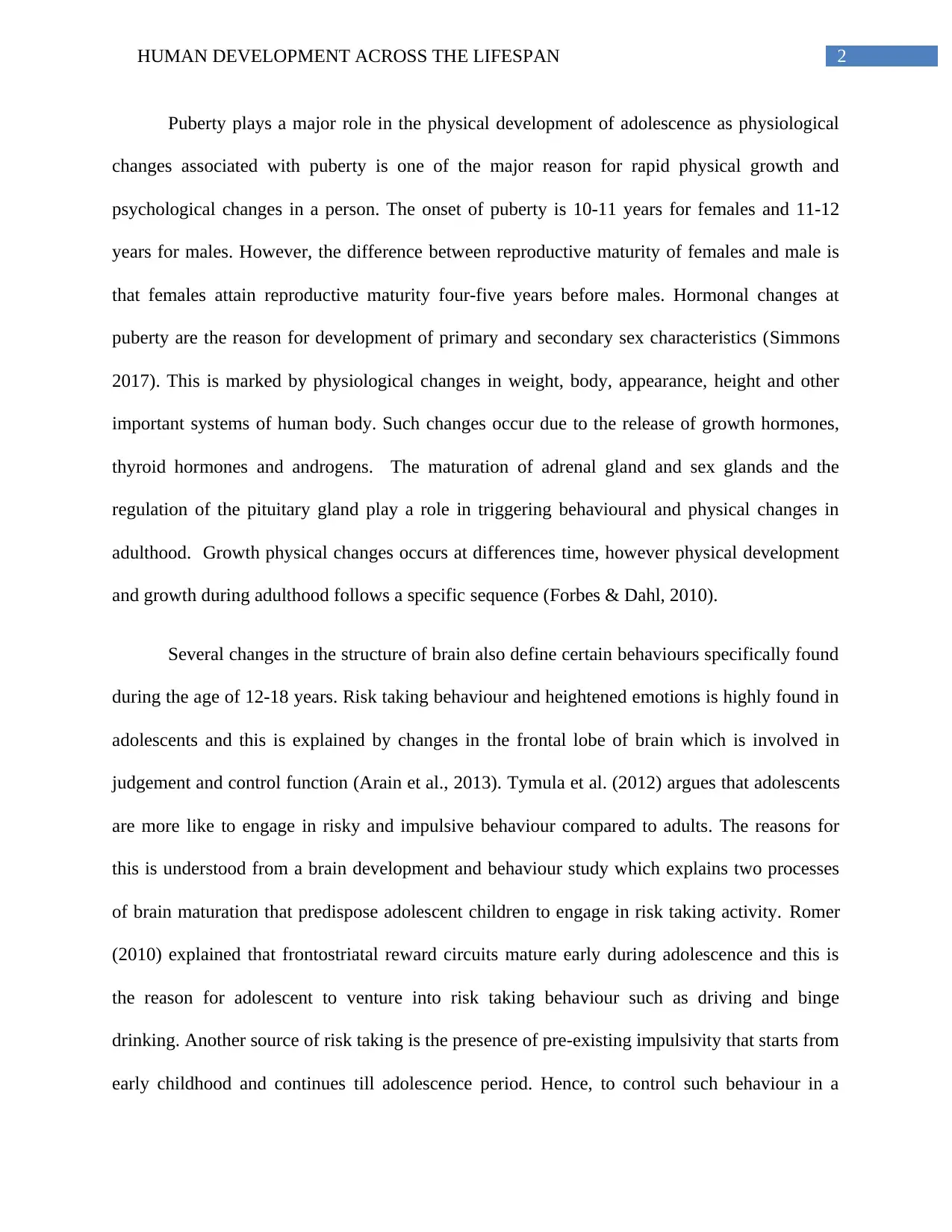
2HUMAN DEVELOPMENT ACROSS THE LIFESPAN
Puberty plays a major role in the physical development of adolescence as physiological
changes associated with puberty is one of the major reason for rapid physical growth and
psychological changes in a person. The onset of puberty is 10-11 years for females and 11-12
years for males. However, the difference between reproductive maturity of females and male is
that females attain reproductive maturity four-five years before males. Hormonal changes at
puberty are the reason for development of primary and secondary sex characteristics (Simmons
2017). This is marked by physiological changes in weight, body, appearance, height and other
important systems of human body. Such changes occur due to the release of growth hormones,
thyroid hormones and androgens. The maturation of adrenal gland and sex glands and the
regulation of the pituitary gland play a role in triggering behavioural and physical changes in
adulthood. Growth physical changes occurs at differences time, however physical development
and growth during adulthood follows a specific sequence (Forbes & Dahl, 2010).
Several changes in the structure of brain also define certain behaviours specifically found
during the age of 12-18 years. Risk taking behaviour and heightened emotions is highly found in
adolescents and this is explained by changes in the frontal lobe of brain which is involved in
judgement and control function (Arain et al., 2013). Tymula et al. (2012) argues that adolescents
are more like to engage in risky and impulsive behaviour compared to adults. The reasons for
this is understood from a brain development and behaviour study which explains two processes
of brain maturation that predispose adolescent children to engage in risk taking activity. Romer
(2010) explained that frontostriatal reward circuits mature early during adolescence and this is
the reason for adolescent to venture into risk taking behaviour such as driving and binge
drinking. Another source of risk taking is the presence of pre-existing impulsivity that starts from
early childhood and continues till adolescence period. Hence, to control such behaviour in a
Puberty plays a major role in the physical development of adolescence as physiological
changes associated with puberty is one of the major reason for rapid physical growth and
psychological changes in a person. The onset of puberty is 10-11 years for females and 11-12
years for males. However, the difference between reproductive maturity of females and male is
that females attain reproductive maturity four-five years before males. Hormonal changes at
puberty are the reason for development of primary and secondary sex characteristics (Simmons
2017). This is marked by physiological changes in weight, body, appearance, height and other
important systems of human body. Such changes occur due to the release of growth hormones,
thyroid hormones and androgens. The maturation of adrenal gland and sex glands and the
regulation of the pituitary gland play a role in triggering behavioural and physical changes in
adulthood. Growth physical changes occurs at differences time, however physical development
and growth during adulthood follows a specific sequence (Forbes & Dahl, 2010).
Several changes in the structure of brain also define certain behaviours specifically found
during the age of 12-18 years. Risk taking behaviour and heightened emotions is highly found in
adolescents and this is explained by changes in the frontal lobe of brain which is involved in
judgement and control function (Arain et al., 2013). Tymula et al. (2012) argues that adolescents
are more like to engage in risky and impulsive behaviour compared to adults. The reasons for
this is understood from a brain development and behaviour study which explains two processes
of brain maturation that predispose adolescent children to engage in risk taking activity. Romer
(2010) explained that frontostriatal reward circuits mature early during adolescence and this is
the reason for adolescent to venture into risk taking behaviour such as driving and binge
drinking. Another source of risk taking is the presence of pre-existing impulsivity that starts from
early childhood and continues till adolescence period. Hence, to control such behaviour in a
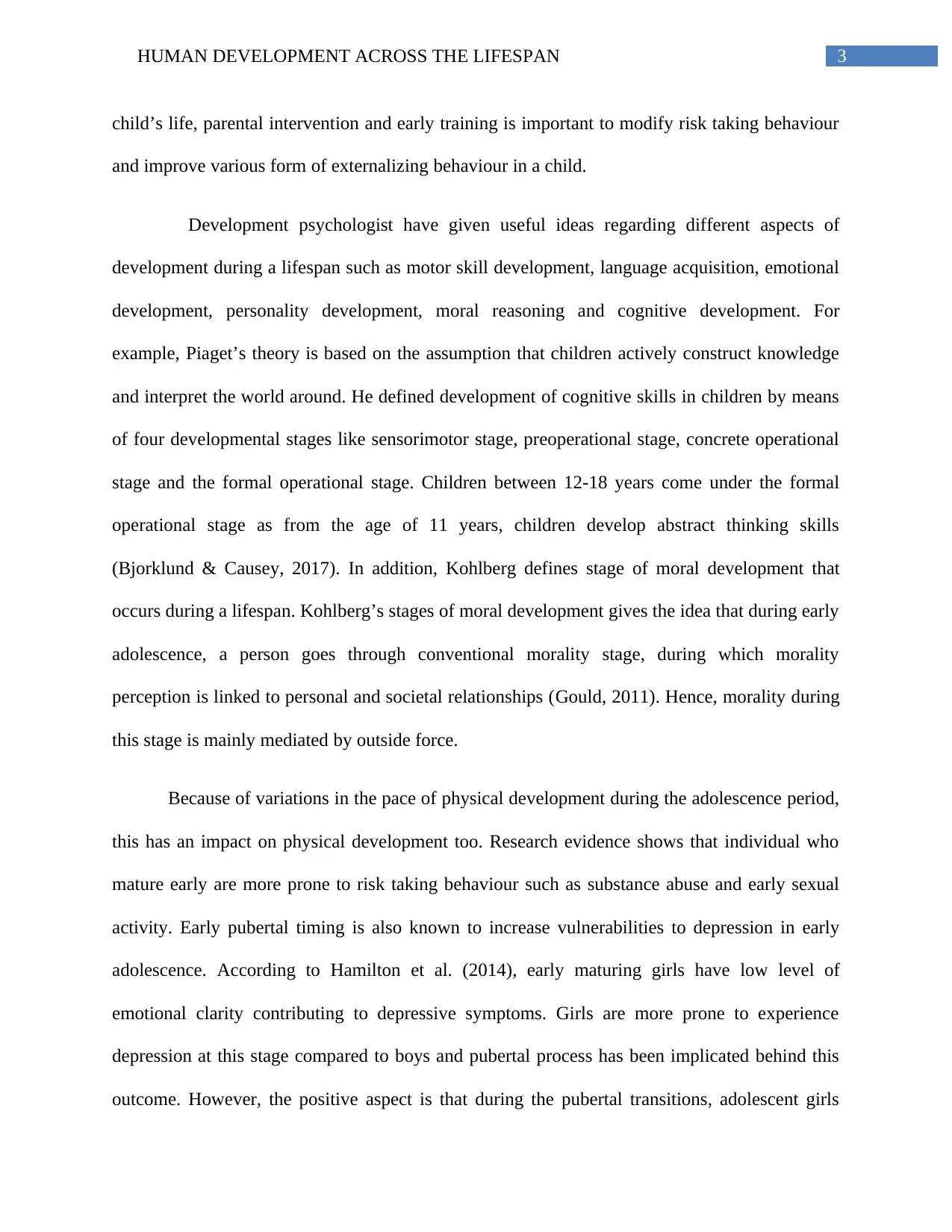
3HUMAN DEVELOPMENT ACROSS THE LIFESPAN
child’s life, parental intervention and early training is important to modify risk taking behaviour
and improve various form of externalizing behaviour in a child.
Development psychologist have given useful ideas regarding different aspects of
development during a lifespan such as motor skill development, language acquisition, emotional
development, personality development, moral reasoning and cognitive development. For
example, Piaget’s theory is based on the assumption that children actively construct knowledge
and interpret the world around. He defined development of cognitive skills in children by means
of four developmental stages like sensorimotor stage, preoperational stage, concrete operational
stage and the formal operational stage. Children between 12-18 years come under the formal
operational stage as from the age of 11 years, children develop abstract thinking skills
(Bjorklund & Causey, 2017). In addition, Kohlberg defines stage of moral development that
occurs during a lifespan. Kohlberg’s stages of moral development gives the idea that during early
adolescence, a person goes through conventional morality stage, during which morality
perception is linked to personal and societal relationships (Gould, 2011). Hence, morality during
this stage is mainly mediated by outside force.
Because of variations in the pace of physical development during the adolescence period,
this has an impact on physical development too. Research evidence shows that individual who
mature early are more prone to risk taking behaviour such as substance abuse and early sexual
activity. Early pubertal timing is also known to increase vulnerabilities to depression in early
adolescence. According to Hamilton et al. (2014), early maturing girls have low level of
emotional clarity contributing to depressive symptoms. Girls are more prone to experience
depression at this stage compared to boys and pubertal process has been implicated behind this
outcome. However, the positive aspect is that during the pubertal transitions, adolescent girls
child’s life, parental intervention and early training is important to modify risk taking behaviour
and improve various form of externalizing behaviour in a child.
Development psychologist have given useful ideas regarding different aspects of
development during a lifespan such as motor skill development, language acquisition, emotional
development, personality development, moral reasoning and cognitive development. For
example, Piaget’s theory is based on the assumption that children actively construct knowledge
and interpret the world around. He defined development of cognitive skills in children by means
of four developmental stages like sensorimotor stage, preoperational stage, concrete operational
stage and the formal operational stage. Children between 12-18 years come under the formal
operational stage as from the age of 11 years, children develop abstract thinking skills
(Bjorklund & Causey, 2017). In addition, Kohlberg defines stage of moral development that
occurs during a lifespan. Kohlberg’s stages of moral development gives the idea that during early
adolescence, a person goes through conventional morality stage, during which morality
perception is linked to personal and societal relationships (Gould, 2011). Hence, morality during
this stage is mainly mediated by outside force.
Because of variations in the pace of physical development during the adolescence period,
this has an impact on physical development too. Research evidence shows that individual who
mature early are more prone to risk taking behaviour such as substance abuse and early sexual
activity. Early pubertal timing is also known to increase vulnerabilities to depression in early
adolescence. According to Hamilton et al. (2014), early maturing girls have low level of
emotional clarity contributing to depressive symptoms. Girls are more prone to experience
depression at this stage compared to boys and pubertal process has been implicated behind this
outcome. However, the positive aspect is that during the pubertal transitions, adolescent girls
Secure Best Marks with AI Grader
Need help grading? Try our AI Grader for instant feedback on your assignments.
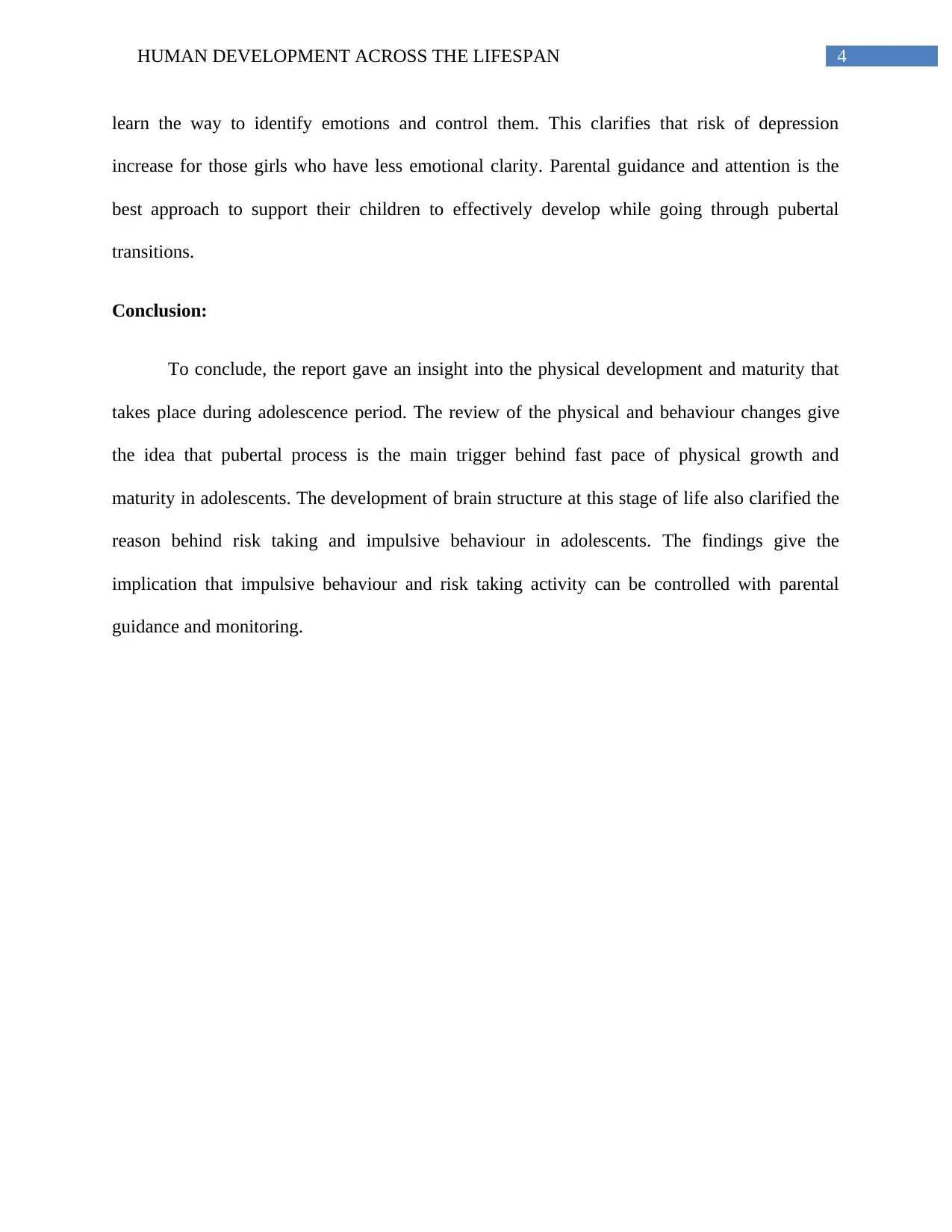
4HUMAN DEVELOPMENT ACROSS THE LIFESPAN
learn the way to identify emotions and control them. This clarifies that risk of depression
increase for those girls who have less emotional clarity. Parental guidance and attention is the
best approach to support their children to effectively develop while going through pubertal
transitions.
Conclusion:
To conclude, the report gave an insight into the physical development and maturity that
takes place during adolescence period. The review of the physical and behaviour changes give
the idea that pubertal process is the main trigger behind fast pace of physical growth and
maturity in adolescents. The development of brain structure at this stage of life also clarified the
reason behind risk taking and impulsive behaviour in adolescents. The findings give the
implication that impulsive behaviour and risk taking activity can be controlled with parental
guidance and monitoring.
learn the way to identify emotions and control them. This clarifies that risk of depression
increase for those girls who have less emotional clarity. Parental guidance and attention is the
best approach to support their children to effectively develop while going through pubertal
transitions.
Conclusion:
To conclude, the report gave an insight into the physical development and maturity that
takes place during adolescence period. The review of the physical and behaviour changes give
the idea that pubertal process is the main trigger behind fast pace of physical growth and
maturity in adolescents. The development of brain structure at this stage of life also clarified the
reason behind risk taking and impulsive behaviour in adolescents. The findings give the
implication that impulsive behaviour and risk taking activity can be controlled with parental
guidance and monitoring.
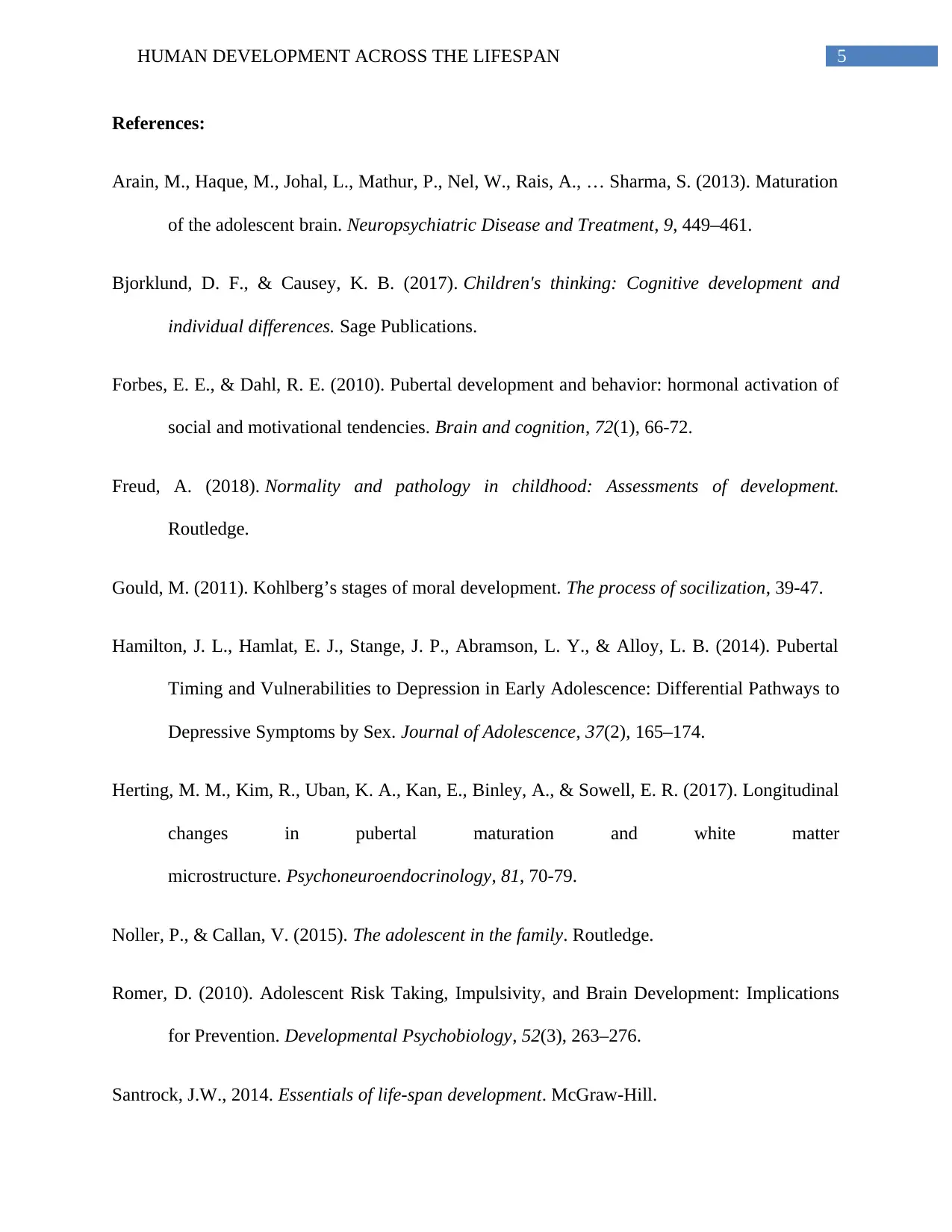
5HUMAN DEVELOPMENT ACROSS THE LIFESPAN
References:
Arain, M., Haque, M., Johal, L., Mathur, P., Nel, W., Rais, A., … Sharma, S. (2013). Maturation
of the adolescent brain. Neuropsychiatric Disease and Treatment, 9, 449–461.
Bjorklund, D. F., & Causey, K. B. (2017). Children's thinking: Cognitive development and
individual differences. Sage Publications.
Forbes, E. E., & Dahl, R. E. (2010). Pubertal development and behavior: hormonal activation of
social and motivational tendencies. Brain and cognition, 72(1), 66-72.
Freud, A. (2018). Normality and pathology in childhood: Assessments of development.
Routledge.
Gould, M. (2011). Kohlberg’s stages of moral development. The process of socilization, 39-47.
Hamilton, J. L., Hamlat, E. J., Stange, J. P., Abramson, L. Y., & Alloy, L. B. (2014). Pubertal
Timing and Vulnerabilities to Depression in Early Adolescence: Differential Pathways to
Depressive Symptoms by Sex. Journal of Adolescence, 37(2), 165–174.
Herting, M. M., Kim, R., Uban, K. A., Kan, E., Binley, A., & Sowell, E. R. (2017). Longitudinal
changes in pubertal maturation and white matter
microstructure. Psychoneuroendocrinology, 81, 70-79.
Noller, P., & Callan, V. (2015). The adolescent in the family. Routledge.
Romer, D. (2010). Adolescent Risk Taking, Impulsivity, and Brain Development: Implications
for Prevention. Developmental Psychobiology, 52(3), 263–276.
Santrock, J.W., 2014. Essentials of life-span development. McGraw-Hill.
References:
Arain, M., Haque, M., Johal, L., Mathur, P., Nel, W., Rais, A., … Sharma, S. (2013). Maturation
of the adolescent brain. Neuropsychiatric Disease and Treatment, 9, 449–461.
Bjorklund, D. F., & Causey, K. B. (2017). Children's thinking: Cognitive development and
individual differences. Sage Publications.
Forbes, E. E., & Dahl, R. E. (2010). Pubertal development and behavior: hormonal activation of
social and motivational tendencies. Brain and cognition, 72(1), 66-72.
Freud, A. (2018). Normality and pathology in childhood: Assessments of development.
Routledge.
Gould, M. (2011). Kohlberg’s stages of moral development. The process of socilization, 39-47.
Hamilton, J. L., Hamlat, E. J., Stange, J. P., Abramson, L. Y., & Alloy, L. B. (2014). Pubertal
Timing and Vulnerabilities to Depression in Early Adolescence: Differential Pathways to
Depressive Symptoms by Sex. Journal of Adolescence, 37(2), 165–174.
Herting, M. M., Kim, R., Uban, K. A., Kan, E., Binley, A., & Sowell, E. R. (2017). Longitudinal
changes in pubertal maturation and white matter
microstructure. Psychoneuroendocrinology, 81, 70-79.
Noller, P., & Callan, V. (2015). The adolescent in the family. Routledge.
Romer, D. (2010). Adolescent Risk Taking, Impulsivity, and Brain Development: Implications
for Prevention. Developmental Psychobiology, 52(3), 263–276.
Santrock, J.W., 2014. Essentials of life-span development. McGraw-Hill.
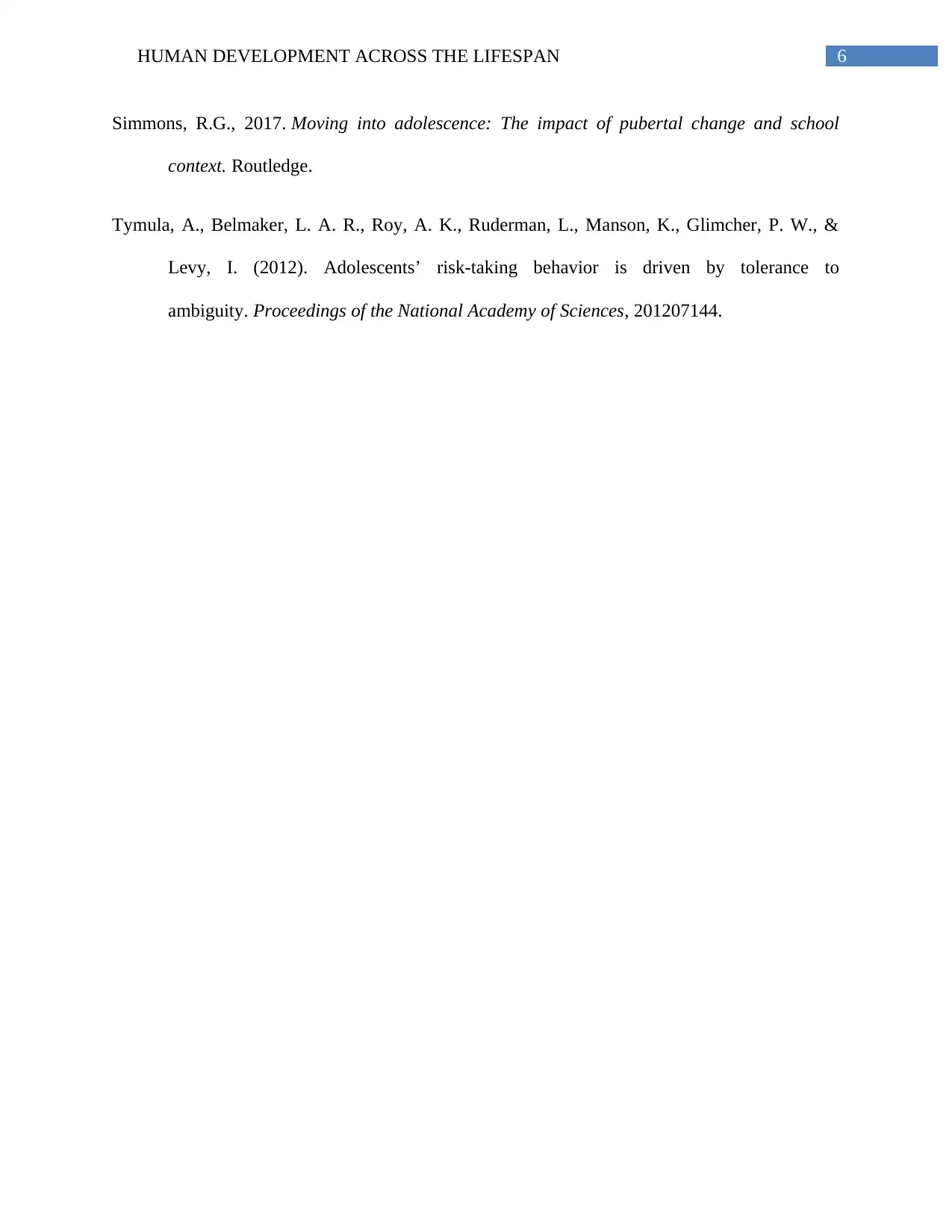
6HUMAN DEVELOPMENT ACROSS THE LIFESPAN
Simmons, R.G., 2017. Moving into adolescence: The impact of pubertal change and school
context. Routledge.
Tymula, A., Belmaker, L. A. R., Roy, A. K., Ruderman, L., Manson, K., Glimcher, P. W., &
Levy, I. (2012). Adolescents’ risk-taking behavior is driven by tolerance to
ambiguity. Proceedings of the National Academy of Sciences, 201207144.
Simmons, R.G., 2017. Moving into adolescence: The impact of pubertal change and school
context. Routledge.
Tymula, A., Belmaker, L. A. R., Roy, A. K., Ruderman, L., Manson, K., Glimcher, P. W., &
Levy, I. (2012). Adolescents’ risk-taking behavior is driven by tolerance to
ambiguity. Proceedings of the National Academy of Sciences, 201207144.
1 out of 7
Related Documents
Your All-in-One AI-Powered Toolkit for Academic Success.
+13062052269
info@desklib.com
Available 24*7 on WhatsApp / Email
![[object Object]](/_next/static/media/star-bottom.7253800d.svg)
Unlock your academic potential
© 2024 | Zucol Services PVT LTD | All rights reserved.




